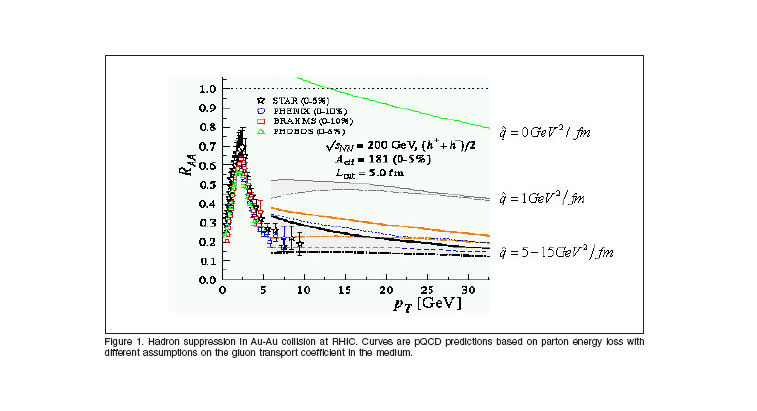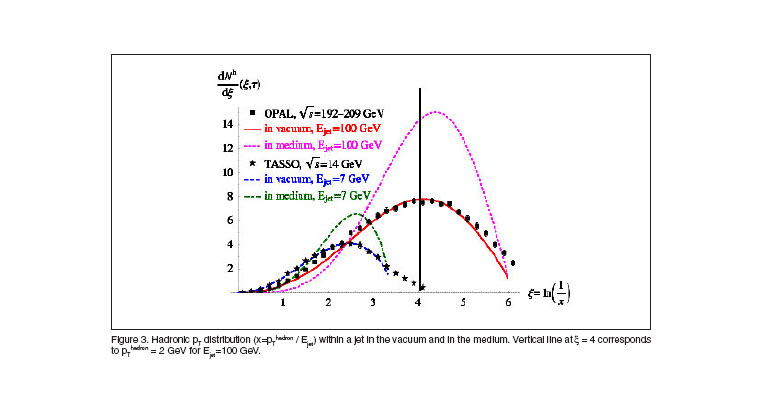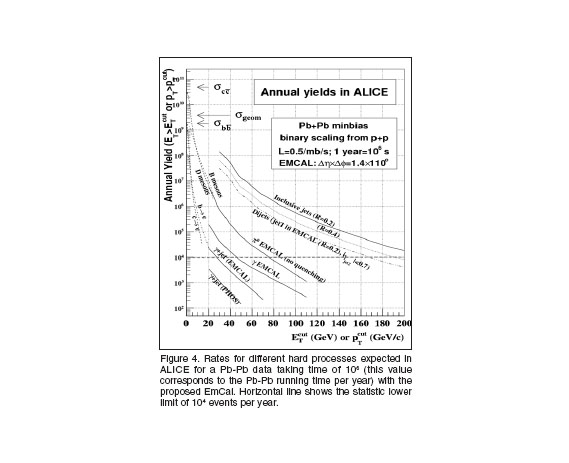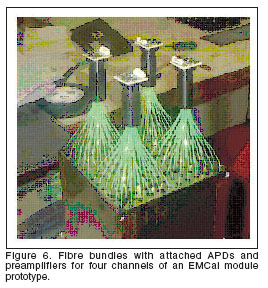Mi SciELO
Servicios Personalizados
Articulo
Indicadores
-
 Citado por SciELO
Citado por SciELO
Links relacionados
-
 Similares en
SciELO
Similares en
SciELO
Compartir
Nucleus
versión impresa ISSN 0864-084X
Nucleus n.41 Ciudad de La Habana ene.-jun. 2007
CIENCIAS NUCLEARES
Jet quenching at alice
Jet quennching en alice
Nicola Bianchi
INFN, Laboratori Nazionali di Frascati, I - 00044 Frascati, Italy
bianchi@lnf.infn.it
ABSTRACT
RHIC results on leading hadron suppression indicate that jets produced in hard processes are strongly quenched by the dense medium created in heavy ion collisions. Several questions on the medium modification of the jet structure have not been yet well addressed. These topics will be better studied at LHC by ALICE at higher pt and with full jet reconstruction. The performances of ALICE on high pt particles and jets can be significantly improved by completing the present set-up with a large electromagnetic calorimeter.
RESUMEN
Los resultados de RHIC en cuanto a la supresión de los principales hadrones energéticos indican que los jets producidos en procesos duros están fuertemente modificados por el medio denso creado en colisiones de iones pesados. Diversos aspectos acerca de las modificaciones de la estructura del jet por el medio no han sido todavía bien investigadas. Estos temas serán mejor estudiados en el LHC por ALICE a mayor pT y con reconstrucción completa del jet. Los resultados de ALICE para partículas de alto pT y jets pueden ser mejorados significativamente si se completa la actual configuración del experimento con un calorímetro electromagnético grande.
Key words: attenuation, energy levels, gev range 10-100, ion collisions, particle production, ALICE, gluons, jet model, quenching
INTRODUCTION
1 - Hadron suppression at RHIC
Two of the most outstanding results from RICH are the leading hadron suppression at high pT (see [1] for a review) and the large washing out of the jet-like azimuthal correlations [2]. Figure 1 shows the suppression of inclusive hadrons in central 200 GeV Au-Au collisions. The data are compared with pQCD predictions where the created medium is characterized by a gluon transport coefficient q=m2/l where m is the typical momentum transfer and l is the gluon mean free path. The huge hadron suppression indicates that a medium of high density is formed in the early stage after the collision. It is to point out that, in the same pT range, the non-QCD particles like the photons are not suppressed like the hadrons. The curves are results of a radiative energy loss calculation that reproduces the measured suppression for an initial gluon density about 30 times the density of cold matter [3,4]. Unfortunately, the pT-range explored by RHIC is quite limited and is not sufficient to study the pQCD evolution of the process, since for pT lower than 6 GeV, non-perturbative phenomena are still important. In addition, the RHIC limitation to measure just the leading hadron inside a jet can provide only an approximate lower limit on the parton energy loss since detected hadrons are mainly generated on the surface of the hot matter.

The study of azimuthal correlations of jet-like events (see figure 2 for a pictorial view) also shows that the hadrons produced in the opposite direction of the detected leading high-pT hadron are strongly suppressed by the dense medium while hadrons produced in the same jet-cone of the leading hadrons are not.

The picture emerging from the experimental results at RHIC is that the state produced in nucleus-nucleus collision at these energies shows a behaviour hardly compatible with the one expected for an ideal gas of free quarks and gluons. It rather looks like a liquid, with a short mean free-path and a large opacity as shown by the suppression of particle production at high pT. This scenario is also supported by recent lattice QCD calculations indicating that substantial interactions are still present even above the critical temperature of the phase transition.
2 - Jet quenching at ALICE
The large energy gap makes extrapolations form RHIC to LHC non-trivial and the system that will be formed in Pb-Pb collisions at LHC might show substantial differences compared with the one formed at RHIC. Expectations from LHC are:
• fireball hotter and denser, lifetime longer
• more weakly interacting Quark Gluon Plasma
• initial gluon density 5-10 times larger
• dynamics dominated by partonic degrees of freedom
• particle production dominated by hard scattering at low x with huge increase of hard probes
RHIC results on leading hadron suppression indicate that most of the energy lost by the leading parton remains within the jet cone, but several questions on the medium modification of the jet structure have not been addressed. These include the longitudinal and transverse structures of the quenched jet, the associated radiation observables, the dependence on the parton flavor. These topics will be studied by ALICE thanks to both the robustness of its tracking (excellent performance for charged particles both at low and high pT from the Time Projection Chamber) and the charged particle identification systems.
Figure 3 shows the expected medium modification of the pT distribution of particles in jets of different energies. As it is seen, large effects are expected in both the low pT (where the other LHC experiments have modest efficiencies) and in the high pT regions. To make ALICE [5,6] better suited for jet physics, the performances on high pT particles and jets can be significantly improved by completing the present set-up with a large Electromagnetic Calorimeter (EmCal) [7]. This would significantly improve the resolution on the jet energy and on the particle composition (with the detection of both charged and neutral particles). It would also allow to calibrate the jet energy by measuring the high energy photon emitted in the opposite direction (g-jet physics). EmCal would be used to trigger on the jet energy itself, thus allowing a significant improvement of the statistics achievable for jets of high energy.

Finally, due too both the g/p0 and the electron/hadron discrimination, EmCal will enhance the ALICE capabilities at high pT for direct photon and heavy quarks (c, b decays into e+ e-) measurements. Figure 4 shows the annual yields expected in one year of Pb-Pb minimum bias events. Assuming a required statistics of 104 events to be collected, the inclusive jet can be studied up to pT of about 200 GeV, while events with two jets (one triggered by the EMCal and the other partially reconstructed only in the TPC) up to 170 GeV. The g-jet rate is statistically robust up to 40 GeV. Single p0 and g can be measured up to about 75 and 45 GeV, respectively, while positrons and electrons from charm and bottom semi-leptonic decay up to about 25 GeV. Study of heavy quark jet production is of interest because the energy loss is expected to be different from that of light quark and gluon jets.

3 - The EMCal project for ALICE
The proposed EMCal will cover the rapidity range of -0.7<h<+0.7 and the azimuthal angle DF= 110o. It will be positioned within the ALICE solenoidal magnet back to back to the smaller PHOS calorimeter (see figure 5). The EMCal will be compose by more than 1.2.104 channels since a high granularity and a large angular coverage are required for the complete jet reconstruction. The technology will be the Shashlik sampling calorimetry with alternate thin layers of lead and scintillator tiles of 1.44 and 1.72 mm respectively. Each counter will be tapered of about 1.5o in order to achieve a projective configuration in the rapidity variable. The detector thickness will be of 20.1 radiation length in order to limit the longitudinal leakage of high energy e.m. showers.

The optical readout will be performed with double cladding Wave Length Shifter fibres coupled with Avalanche Photo Diodes (see figure 6). The preamplifiers and the front end electronics will be derived from the ones already planned for the PHOS detector. The expected performances for e.m. showers are an energy resolution better than 10%/ÖE (GeV) and a spatial resolution better than 1 cm. A charged pion rejection factor of about 400 will be feasible with an electron efficiency of about 90%. The g/p0 separation will be performed by using different techniques: two-photon invariant mass reconstruction for pT up to about 10 GeV, event by event shower shape pT for up to about 30 GeV and isolation cuts for higher pT. Finally the EMCal will provide a fast, efficient trigger for high pT jets, and single g, p0 or electrons with recorded yields enhanced by factors ranging from about 10 (for jets in Pb-Pb collisions) up to 60 (for single particles in p-p collisions).

EMCal Collaboration is composed by several groups from CERN, France, Italy, Russia and USA. R&D programs have been already approved and funded by the respective funding agencies. Since jet physics is foreseen to be addressed during the first five years of LHC, EMCal should be completed and commissioned in 2010, but with small (large) fraction already to be installed for the 2008 (2009) run.
REFERENCES
[1] KLAY JL. J Phys G. 2005;( 31): S451.
[2] ADAMS J, et al. Phys Rev Lett. 2003;( 91): 072304.
[3] WANG E, WANG XN. Phys Rev Lett. 2002;( 8): 162301-2.
[4] AIRAPETIAN A, HERMES Collaboration. Eur Phys J C. 2001;( 20): 479.
[5] AIRAPETIAN A, HERMES Collaboration. Eur Phys JD. 2004;( 29): 21-2.
[6] ALICE Collaboration. CERN/LHCC 95-71.
[7] ALICE Collaboration. J Phys G. 2004;( 30): 517.
[8] ALICE Collaboration. J Phys G. 2006;( 32): 1295-8.
[9] ALICE Collaboration. CERN/LHCC 06-014.













